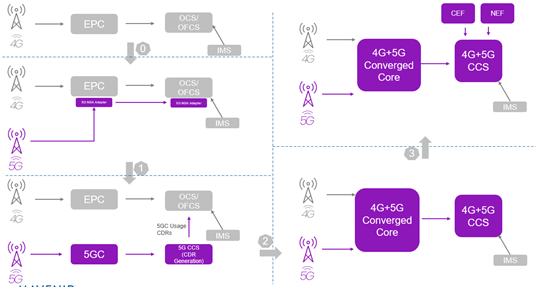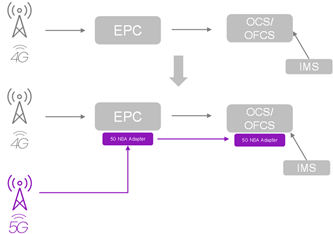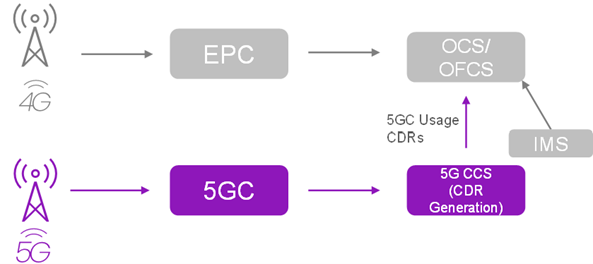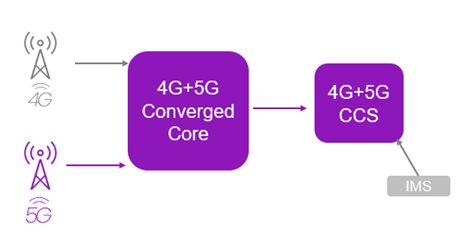What Does 5G Charging Have to Offer and How to Get There?

As we see more and more 5G networks coming to life, it’s interesting to look back at the evolutionary path for charging systems within the new 5G networks. Here are a few of the 3GPP changes to the fundamental charging system standards:
Convergence
With 5G, the Charging solution is named “Converged Charging System (CCS).” The term ‘converged’ emphasizes the convergence of online and offline charging models within 5G CCS. The new charging architecture can now handle offline (postpaid) and online (prepaid) charging models using the same platform. Traditionally, most CSPs had to deploy different charging solutions to address prepaid and postpaid segments, resulting in a spaghetti architecture for rating and charging. Hence, this convergence is a major but welcome change to simplify the complex charging ecosystems that most CSPs have amassed.
Service-Based Architecture
Like the rest of the 5G core, CCS also employs a Service-Based Architecture (SBA). This means the network functions within the 5G CCS are all designed as microservices; they interact with the external world using a Service-Based Interface (SBI). These interfaces are modern REST APIs based on HTTP protocol instead of the traditional Diameter-based interfaces. This new architecture allows the solution to be very granular with the option to deploy only necessary microservices, scale them on demand, and deploy them at the edge of the network, the central data center, or both. The ability to be auto-discovered in a distributed 5G network by registering with the 5G Network Repository Function (NRF) provides significant flexibility and resiliency in multi-location, distributed cloud networks.
CDR Generation Responsibility
5G CCS is the only node in the entire 5GC that can generate usage call data records (CDRs). In past EPC architectures, CDRs were generated individually by different network elements such as P-GW and S-GW, which is another significant change. However, with 5G, all the gateway nodes such as SMF and AMF will no longer generate CDRs directly. Instead, they will use the CDR generation capability within the CCS. They all need to invoke the new charging function (Nchf) APIs of CCS to pass on the charging event, and then CCS generates the CDRs in 3GPP TS32.298-based format. Thus, with 5G, CCS assumes an indispensable and central role in all aspects of network monetization, no matter how simple or complex the charging use cases may be.
Charging for Network Slices, Network Access, and API Calls
Network slicing is one of the key use cases enabled by 5GC. Charging for network slice requires a new set of capabilities than those available with the traditional charging solutions. This newly defined network function capability is called the Charging Enablement Function (CEF). It’s expected to be an integral part of the overall 5G Charging solution. In addition, 5G CCS is also designed to accommodate the charging and monetization requirements of the digital economy. Now, enterprises can be charged based on access to the network, coming via 5G Access Management Function (AMF) or charged on a per-network service usage basis based on the API calls invoked via 5G Network Exposure Function (NEF).

Due to fundamental changes in the architecture, underlying business models, and the role of CCS in the 5GC, it has become quite important for CSPs to carve out their roadmap to move to this new charging system architecture. While each CSP has its unique transformation path towards 5G, Figure 1 depicts a typical 4-step journey that Mavenir foresees based on the interactions with our large CSP customer base:
Step 1. Introduce 5G services with Non-Standalone (NSA) mode, using Option 3/3a/3x [Details]
With this implementation, CSPs could claim 5G readiness in the market and offer higher bandwidth mobile broadband at premium prices to LTE customers.

Option 3x-based 5G NSA implementations let CSPs leverage existing LTE Evolved Packet Core (EPC) with minor upgrades. This also applies to the charging system, which needs an upgrade to support additional AVPs in the existing Diameter interfaces. While such upgrades in EPC and legacy charging systems may help CSPs claim to be ‘5G Ready,’ this isn’t a long-term solution. This update doesn’t help accomplish the required transformation journey, which can only be fulfilled by transitioning to a new standalone 5G Core (5GC) and 5G Converged Charging System (CCS).
Step 2. Introduce 5G SA mode, starting with limited use cases
The goal is to launch “real” 5G services with FWA, eMBB for enterprises and premium consumers, followed by ubiquitous 5G eMBB.

With 5G SA mode, 5GC and the 5G CCS are introduced in the network. However, we see that most CSPs are not ready to implement 5GC and 5G CCS at the same time. While a new 5GC is being deployed in the network, CSPs prefer the new 5GC to integrate with their existing charging system (OCS and or OFCS). However, remember that in 5GC, the only network function that generates usage CDRs is the 5G CCS. This means the bare minimum implementation of a 5G CCS is still required, even if the sole purpose is to generate usage CDRs to feed the old Offline Charging System (OFCS) for carrying out Rating and Billing. Thanks to the SBA, 5G CCS can be deployed with only the required microservices from CHF and CGF network functions to support this use case. Thus, most early-stage 5GC SA deployments start with this limited scope 5G CCS for the CDR generation capability.
Step 3. Seamless support for 4G + 5G services with a Converged Packet Core
This moves towards completing the transformation journey by keeping both 4G and 5G subscriptions and services under a common core network and charging system. 
While the previous milestone helped CSPs launch some of the actual 5G services, they still adopted an add-on approach by having an adjunct SA 5GC + minimal 5G CCS deployed in parallel to the EPC and OCS + OFCS. At this stage, CSPs can start moving to convergence by deploying Converged Packet Core, which is just like enabling that option in the 5GC deployed in the previous step. Along with a Converged Packet Core, the 5G CCS also needs to support technology convergence by adding charging for both 4G and 5G services under the same platform. Additionally, the 5G CCS also needs to support charging for IMS services such as VoLTE, VoWiFi, RCS, SMS, and MMS over the traditional interfaces such as Diameter Ro. 3GPP has not defined this technology convergence in 5G CCS; however, the only practical option is to have an equivalent of Converged Packet Core in the charging domain to help CSPs complete their transformation journey from legacy charging systems to the 5G CCS.
Step 4. Explore advanced 5G use cases
This now allows CSPs to launch advanced 5G services such as network slices, edge charging, etc.
When CSPs have completely transitioned to a new 5GC (including Converged Packet Core) and 5G CCS, they can start exploring the new monetization avenues that 5G has to offer. Here are some of the new monetization scenarios CSPs can start exploring now:
1. Monetization of network slicing. Processing events related to network slice management (provisioning) and network slice analytics (slice usage, adherence to SLA, QoS, etc.) cannot be directly fed into CCS. They need to be analyzed, transformed, and enriched before they can be charged by CCS. This job is assigned to the new NF called CEF. Mavenir CCS includes the CEF functionality as part of the overall charging solution.
2. Enable charging for edge computing and MEC applications. Edge computing can host applications close to the UE’s access point of attachment. This helps achieve an efficient service delivery through the reduced end-to-end latency and load on the transport network. From a charging viewpoint, the CCS needs to differentiate between user and MEC application traffic that was routed via local data network or public data network, and then charge for it accordingly. This may require deploying 5G CCS NFs in a distributed manner to have only the required services at the edge (e.g., authorization only) while having all the services at the central data center.
3. Charging for sporadic network access instead of charging based on usage. This is especially important for MMTC and IIoT use cases where millions of IoT devices and sensors will sporadically access the network to upload their statistics (a very small payload). CCS must support different charging and rating models since the enterprise is to be charged for the volume of network access events.

4. Enabling charging per API calls. With 5G, CSPs can finally achieve their goals of becoming “Digital Service Providers (DSP).” However, to monetize a digital service, CSPs need the ability to expose their own network capabilities via APIs and then charge per API invocation. A typical example is the way CSPs have started selling CPaaS to enterprise customers and charging them based on API invocations via the CPaaS platform. The 5G CCS can enable CSPs to monetize and charge for any digital services exposed via the 5GC Network Exposure Function (NEF).
5G brings newer business models and never imagined services CSPs can offer their enterprise and consumer customers. But it also emphasizes the need for evolution to a new 5G CCS charging and monetization architecture. Learn how Mavenir’s portfolio, which includes the 5G CCS, can help your transformation.
Learn more about Mavenir’s Digital Enablement Plaform.


